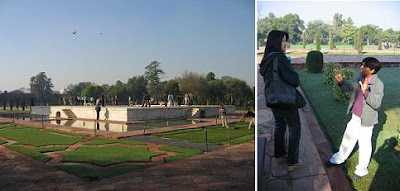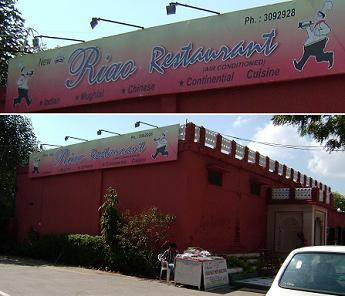
0729HR Breakfast at the not turning ‘revolving restaurant’

0822HR on our way to Taj Mahal via the battery-operated vehicle.
 In recent years there has been growing concern about damage from atmospheric pollution. Acid rain, produced by sulphur dioxide from vehicle and industrial emissions, began to discolour the famous white marble and erode the fine carving and inlays. In an attempt to reduce pollution, new industrial developments in Agra were banned in 1994, and only non-polluting vehicles are allowed in the immediate vicinity of the Taj. Over 200 industries have been ordered to move out of this area, and cars, buses and scooters are banned within a 500 meters radius of the Taj, but Agra remains a highly congested and polluted city and the fumes may one day take their toll on this most beautiful of India’s buildings.
In recent years there has been growing concern about damage from atmospheric pollution. Acid rain, produced by sulphur dioxide from vehicle and industrial emissions, began to discolour the famous white marble and erode the fine carving and inlays. In an attempt to reduce pollution, new industrial developments in Agra were banned in 1994, and only non-polluting vehicles are allowed in the immediate vicinity of the Taj. Over 200 industries have been ordered to move out of this area, and cars, buses and scooters are banned within a 500 meters radius of the Taj, but Agra remains a highly congested and polluted city and the fumes may one day take their toll on this most beautiful of India’s buildings.0841HR at the entrance gateway, opposite the South Gate.
Entry to the inner compound is through this 30m red sandstone gateway, which is inscribed with verses from the Koran.

14FEB07 Valentine’s Day, what a good day to visit the most extravagant monument ever built for love.
Many have tried to sum up its beauty –
‘a teardrop on the face of eternity’ according to Indian poet Rabindranath Tagore,
‘the embodiment of all things pure’ according to British writer Rudyard Kipling.
Here I was to ‘feel’ it for myself.
0844HR the Taj Mahal
As you enter, you see the first picture postcard view of the Taj, floating above the ground, its great dome deceptively near.

0852HR The garden, divided into eight squares in the Mughal charbagh (formal Persian garden) style is laid out along the central waterway in front of the mausoleum. Rows of cypresses line this long canel and the lotus pool, named after the lotus-shaped fountain spouts. The perfectly symmetrical reflection of the Taj in the water of the lotus pool emphasizes the marvel of its architecture.
 0853HR
0853HR 0901HR The ornamental gardens are set out along classical Mughal charbagh lines – a square quartered by watercourses, with an ornamental marble plinth at the centre.
0901HR The ornamental gardens are set out along classical Mughal charbagh lines – a square quartered by watercourses, with an ornamental marble plinth at the centre. 0907HR
0907HR
0913HR The red sandstone mosque to the west of the main structure is an important gathering place for Agra’s Muslims. There’s a identical building to the east, the jawab, which was built for symmetry. The mosque is impressive, but pales in comparison to the Taj.
 The Taj stands on a marble platform at the northern end of the ornamental gardens, about 8 meters high and covering an area of 95 square meters. Raising the Taj up means that the backdrop is only sky – a master stroke of design.Four purely decorative slender white minarets grace each corner of the platform. After more than three centuries they are not quite perpendicular, but they may have been designed to lean slightly outwards so that in the event of an earthquake, they would fall away from the precious Taj.
The Taj stands on a marble platform at the northern end of the ornamental gardens, about 8 meters high and covering an area of 95 square meters. Raising the Taj up means that the backdrop is only sky – a master stroke of design.Four purely decorative slender white minarets grace each corner of the platform. After more than three centuries they are not quite perpendicular, but they may have been designed to lean slightly outwards so that in the event of an earthquake, they would fall away from the precious Taj.0915HR
View of the Ornamental Gardens from the east side nearer the main Taj structure.
Story telling time by our local guide. ST was standing on my left initially. She claimed that we two were so engrossed that we never moved our eye-contact. So she moved to my right to capture this to show me, hahaha…...
 The love story of the emperor Shah Jahan and Noor Mahal, or Mumtaz Mahal, is well known throughout India. Shah Jahan, or Prince Khurram, as he was known before he ascended the throne, fell madly in love with the beautiful Arjumand Banu Begum, married her and gave her the title Mumtaz Mahal (Exalted one of the Palace).
The love story of the emperor Shah Jahan and Noor Mahal, or Mumtaz Mahal, is well known throughout India. Shah Jahan, or Prince Khurram, as he was known before he ascended the throne, fell madly in love with the beautiful Arjumand Banu Begum, married her and gave her the title Mumtaz Mahal (Exalted one of the Palace).When she died in 1631 while giving birth to her 14th child, the emperor was so distraught that he mourned her death for two years, his hair turned grey overnight and he even stopped eating meat or listening to music. Quite a sacrifice for the high living Mughals!
He promised to build the most beautiful mausoleum ever known to the world.
0919HR



It has been said that the only discordant note in the Taj is, ironically enough, the tomb of Shah Jahan which his usurping son Aurangzeb placed next to that of Mumtaz in 1666.
The building was designed so that Mumtaz’s tomb would be its single centerpiece under the central dome – Shah Jahan’s tomb breaks the pattern.
Sunrise and sunset are the best times to visit the Taj Mahal. The marble catches and reflects the light in such a manner that it would seem as though the architects and designers were seeking some sort of union with the sun and moon, so that their creation would complement the movements of the heavenly bodies. The Taj has been described the Islamic concept of paradise.
0936HR see the replacement touch-up portion
1003HR at the back of the main structure
View of the Agra Fort from Taj Mahal.
Agra Fort – Construction of the massive red-sandstone fort and palace on the bank of the Yamuna River, was begun by Emperor Akbar in 1565. Further additions were made particularly by his grandson Shah Jahan, who added buildings using his favourite building material white marble. The fort was built primarily as a military structure, but Shah Jahan upgraded it to a palace, and later it became his gilded prison for eight years after his usurping son Aurangzeb seized power in 1658.
Some say that Shah Jahan planned a black Taj on the opposite bank of the Yamuna, but there is no evidence that construction was ever begun on such a structure.
1013HR



1045HR bye, from the East Gate.
All the marble was imported from Rajasthan, turquoise from Persia and diamonds from central Asia. The names of the architects are unknown. Some sources say that the chief architect was one Ustad Ahmad Lahori, others say it was Persian Isa Khan. Designers were brought in from overseas – Mohammad Afandi from Turkey, Mullah Mushid from Persia and Geronimo Veroneo, whose grave can be found in the Roman Catholic cemetery in Agra, from Venice.
The Taj was built to resemble paradise on earth and the doors of the gateway were apparently once made of solid silver that was later plundered by invading tribes of Jats.
1153HR view of Taj Mahal from Agra Fort.

Well, the consolation – from here, at least he could still see the Taj Mahal, where his beloved wife was buried?
I’m silenced by this stunning love story, not by the structure that is almost vulnerable in its purity.
I’m struck by the ethereal sad beauty of the Taj Mahal.
As what I told ST, it’s like fairy-tale, a man loving a woman so deeply, almost non-existence in real life.
1210HR Lunch at:



It is an irony that one of India’s greatest kings is buried in a small village 8km from Agra.
The mausoleum has no dome. Instead groups of chhatris are arranged along the roof. A chhatri with three arches, decorated with a profusion of intricate patterns in marble and black slate, towers above the massive arched gateway.
1355HR
 1357HR Sikandra - Emperor Akbar's Tomb
1357HR Sikandra - Emperor Akbar's Tomb
Emperor Akbar (1556-1605) started the construction himself, blending various elements just as his religious and political philosophy did.The tomb was completed by Jahangir.
1410HR



1423HR
1945HR checked in Hotel Mohan International
Remember the porter who rejected my INR5 tip, claimed that INR5 is of no value, on my first day in Delhi, 09FEB07?
When ST paid INR20 for the bill of INR17.66 for the Mineral Water she ordered, that porter asked her if he could keep the balance (INR2.34)!
2019HR Dinner - Vege Korma, Missi Roti, Vege Burger, Vege Sweet Corn Soup, Mix Vege Pakora, Chana Masala and Half Set Tea, total INR270 (about S$9.60)






No comments:
Post a Comment